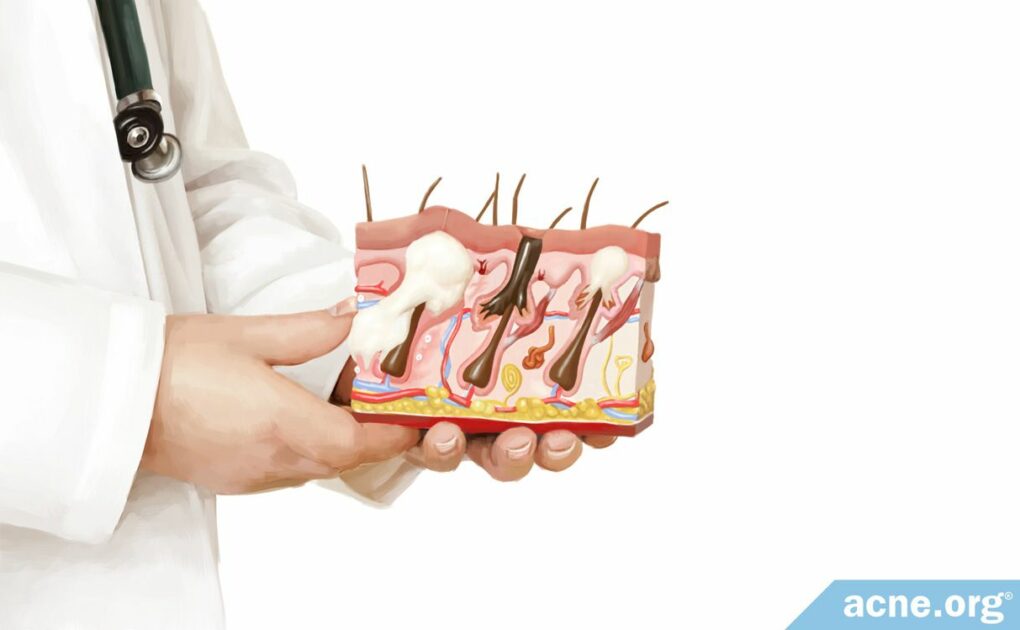While All Dermatologists Have Some Knowledge of Acne, Only Those with a Special Interest in Acne Seek out Additional Training and Become Experts

The Essential Info
Dermatology is a broad field that deals with over 2,000 skin diseases, and the study of acne makes up only about 2% of the medical school curriculum devoted to dermatology.
There is no official sub-specialty of dermatology devoted to acne. Therefore, once a dermatologist has completed her medical training, whether she focuses on acne by continuing to stay up-to-date on the latest acne research and treatments requires motivation on her part. Dermatologists who seek out conferences and workshops and choose to focus on acne patients in their practice can become acne experts. However, the average dermatologist with no particular interest in acne is unlikely to be an acne expert.
What does this mean in the real world? You have to be your own advocate. Doctors tend to come across as confident in their advice. But it’s up to you to make sure the advice you’re getting is sound. It’s also best to make sure if you are seeing a dermatologist for acne, you are seeing one who is an acne expert.
Helpful Tool to Find a Dermatologist Who Is an Acne Expert: American Academy of Dermatology: Find A Dermatologist

The Science
- Click here to Skip Down to How to Find a Dermatologist Who Is an Acne Expert
- How to Become a Dermatologist
- How Much Do Dermatologists Learn about Acne after Their Formal Training Is Finished?
- The Bottom Line
In most cases, you can successfully treat acne at home by following an appropriate skin care regimen. However, some people who have very severe acne or a hormonal imbalance may need to consult a dermatologist.
All dermatologists have some familiarity with acne, but by far not all are acne experts. The formal training a dermatologist receives covers a huge number of skin diseases, with only a small fraction of time devoted to acne.
Whether or not a particular dermatologist becomes an acne expert depends entirely on her professional interests after she finishes all of her medical training. Dermatologists who are motivated to learn more about acne can choose to attend specialized conferences, read the latest research, and focus their practice on acne patients. These are the dermatologists you want to zero in on if you decide to see a doctor about your acne.
Let’s take a look at the steps required to become a dermatologist so we can see how relatively little time in each step is devoted to learning about acne.
How to Become a Dermatologist
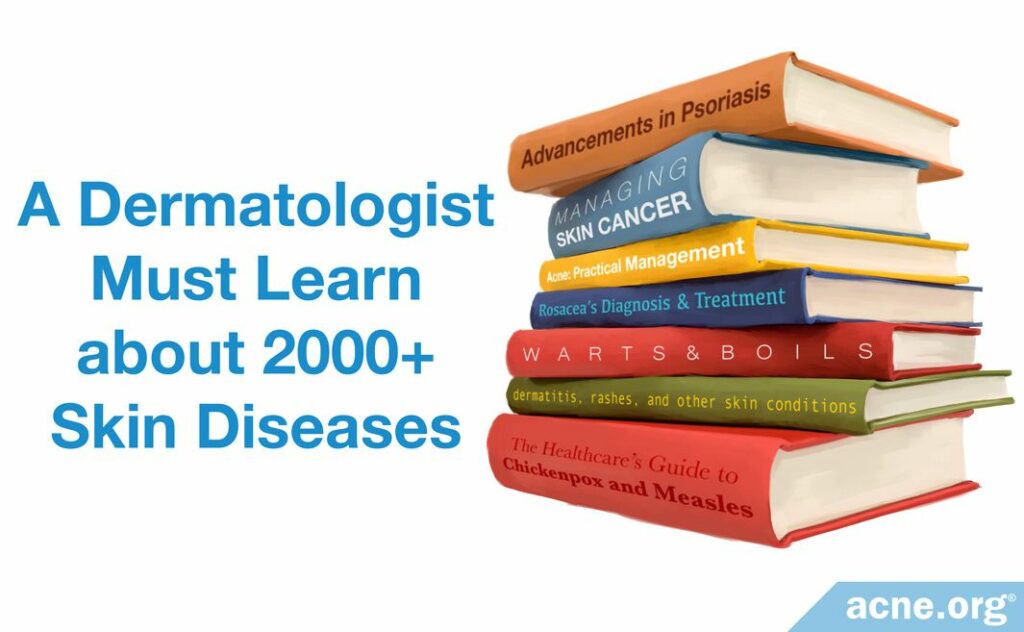
Becoming a dermatologist is a long process with at least four stages in the United States:1,2
Step 1: Studying in college/university to earn a bachelor’s degree over 4 years.
Step 2: Attending medical school to become a medical doctor (MD) or doctor of osteopathic medicine (DO) over 4 years.
Step 3: Completing an internship over 1 year. This is where a dermatologist starts focusing on skin, hair, and nails.
Step 4: Completing a residency program in Dermatology over 3 years or more.
[Optional] Step 5: Completing a fellowship program over 3 years to sub-specialize and receive advanced training in one of these four areas (none of which are acne-specific):
- Cosmetic dermatology
- Pediatric dermatology
- Dermatopathology – the study of skin diseases on a microscopic or molecular level
- Dermatologis oncology/Mohs surgery – skin cancer & skin cancer surgery
The first two steps are the same for any future doctor. After completing these two steps, a doctor can place the initials MD or DO after her name, meaning that she has graduated from medical school, but her training is far from finished.
The difference between a dermatologist and, say, an otolaryngologist (an ear, nose, and throat doctor) is what they focus on after they complete medical school. This is when a dermatologist begins to work exclusively with diseases of the skin, hair, and nails.
To work as a dermatologist in the United States, a doctor has to complete Steps 1-4 and pass board exams given by one of the following professional organizations:
- The American Academy of Dermatology
- The American Osteopathic Board of Dermatology
- The Royal College of Physicians and Surgeons of Canada1
After passing these exams, the dermatologist is “board-certified” and can add the initials FAAD (Fellow of the American Academy of Dermatology) after her name. In other words, a board-certified dermatologist’s door plaque should look like “Jane Smith, MD, FAAD” or “Jane Smith, DO, FAAD.”
How Much Do Dermatologists Learn about Acne During Their Training?
Since there are over 2,000 skin conditions, it is natural that a dermatologist’s education is not focused on a single disease like acne. A dermatologist has to be able to identify, diagnose, and treat any kind of skin condition that shows up in her patients, from mild ones like sunburn to life-threatening ones like skin cancer.
Let’s look at how little time a dermatologist spends learning specifically about acne at each stage of her training.
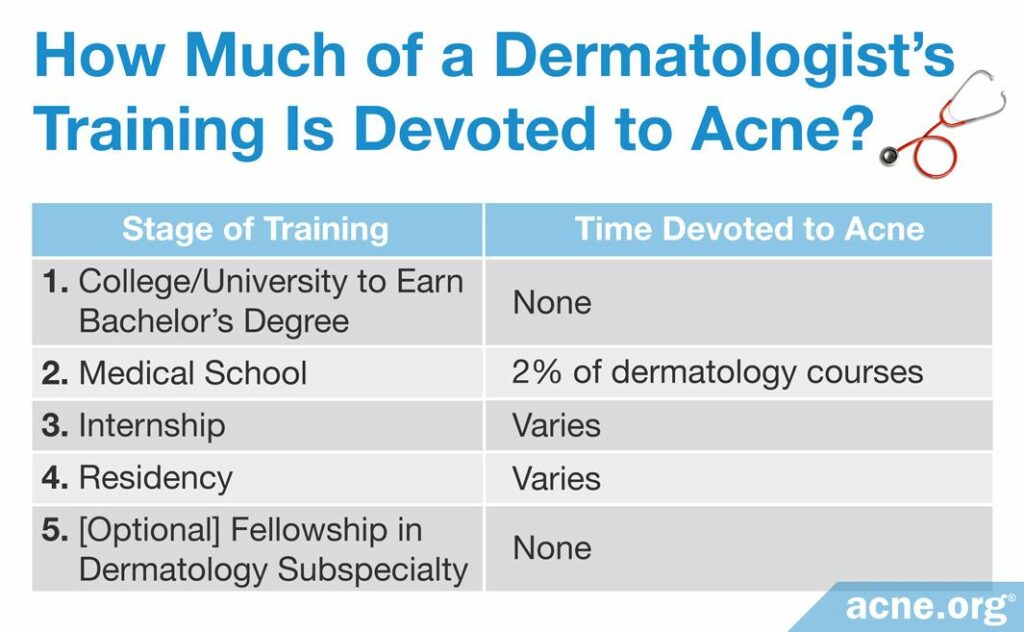
Acne training in Step 1, earning a bachelor’s degree
In step 1, a future doctor is still studying for her bachelor’s degree, so she takes courses like Human Biology and Organic Chemistry and learns nothing yet about treating diseases like acne.
Acne training in Step 2, medical school
Very little time is spent focusing on acne during medical school. We can get a good sense of how much doctors learn about acne in medical school by seeing what portion of their textbooks is devoted to acne:
- Rook’s Textbook of Dermatology This is one of the main dermatology textbooks is in the U.S., and it is 4,362 pages long. In this textbook, acne is mentioned 2,940 times and has an 85-page chapter dedicated to it. In other words, about 2% of the book is about acne.
- Clinical Dermatology by John C.Hunter, John Savin, and Mark Dahl: This is a smaller dermatology textbook. It is 350 pages long, and only 8 of those pages are dedicated to acne. In other words, again, about 2% of the book is about acne.3,4
We can see that medical school students do learn about acne in some detail – for example, many read an 85-page textbook chapter about it. However, acne still makes up only 2% of their classroom education on dermatology.
We also need to remember that dermatology is only one of many areas of medicine that future doctors learn about. In other words, learning about acne makes up a tiny fraction of medical school training.
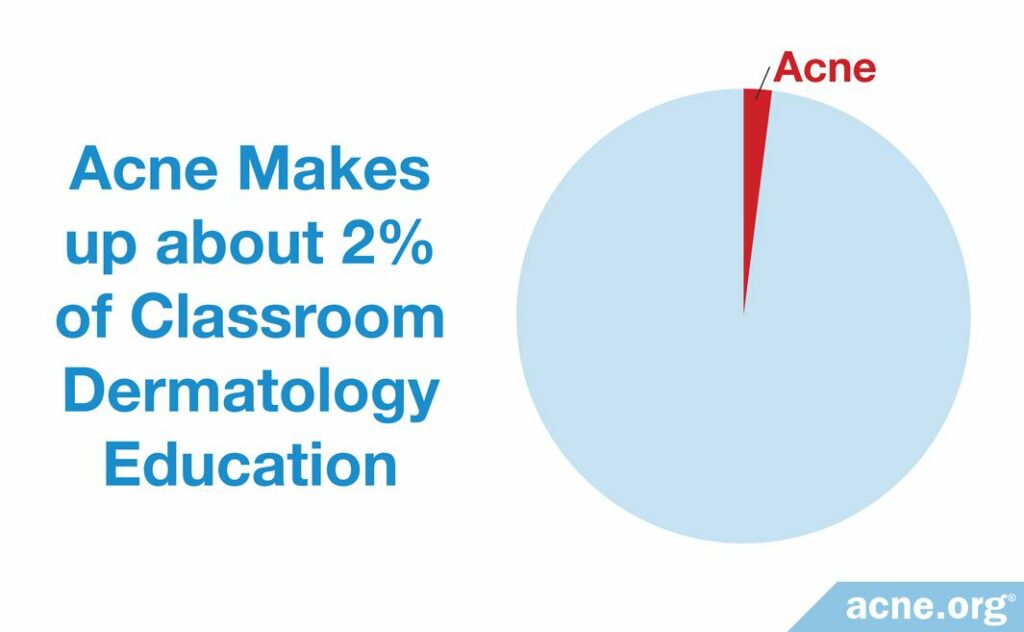
Acne training during steps 3 and 4, internship and residency
During internship and residency, a doctor just out of medical school receives hands-on training in conditions she will be treating later in her practice. Thus, a beginning dermatologist sees patients with various skin diseases and learns how to treat them under the supervision of more experienced dermatologists.
How many acne patients a dermatologist sees during this time depends on several factors:
- The country where she completes her internship and residency
- The type of clinic or hospital where she undergoes her training
- The age of patients she mostly sees during her training
Country
In general, dermatologists in westernized societies tend to see more patients with acne than dermatologists in non-westernized countries.4 For example, in the:
- U.S.A.: Acne is the number one condition American dermatologists see. In other words, a dermatologist who completes her hands-on training in the U.S. will likely gain a lot of experience with acne.
- U.K.: Acne is the second most common condition dermatologists in the U.K. see. In other words, a dermatologist who completes her hands-on training in the U.K. will likely gain a lot of experience with acne.
- Ethiopia: Acne is not among the skin conditions an Ethiopian dermatologist is likely to see. Instead, she is more likely to deal with various skin infections. In other words, a dermatologist who completes her hands-on training in Ethiopia may not gain much experience with acne.3-5
Type of clinic or hospital
The type of clinic or hospital where a dermatologist performs her internship and residency influences how many acne cases she gets to see. For example, if she chooses to do a residency in a burn care unit, she will treat many patients with burns but will probably gain very little experience with acne. Likewise, if she completes her residency in an urgent care clinic, she will be dealing mostly with severe and sudden disorders and will devote almost no time to acne.
On the other hand, a resident in a general dermatology practice will likely see many patients with acne and gain experience with the full spectrum of acne severity. This is because acne is the most common skin condition, affecting up to 85% of adolescents.6
If a dermatologist wants to learn as much as possible about acne, she may even choose to perform her residency in a practice focusing specifically on acne patients.
Age of patients
The most common skin condition a dermatologist is likely to see also depends on the ages of her patients.
If she does her residency in a pediatric clinic and mostly treats infants and young children, she will not gain much experience with acne.

For example, a U.S. survey conducted over 17 years and published in the Dermatology Online Journal in 2014 showed that in the 0-4 age group, the most common skin condition is atopic dermatitis (a type of rash).7
The same survey found that for patients over 45, the most frequent diagnosis is actinic keratosis (a scaly patch on the skin). In other words, a resident who works with a mature patient population may also not see much acne in her training.
However, for patients between the ages of 5 and 44 in the U.S., acne remains the #1 condition that dermatologists see. Therefore, there is a good chance that a dermatologist who performs her residency in a general dermatology practice will see plenty of acne cases during her training.
To sum up, a dermatologist who completes her internship in an American general dermatology practice dealing with teens and adults gains quite a lot of hands-on experience with acne.
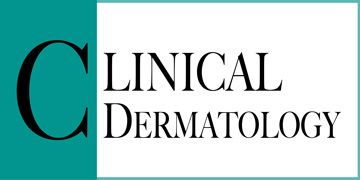
According to the Clinical Dermatology textbook by John Hunter and co-authors, “in the U.S.A., nearly half of all visits to dermatologists are for one of three diagnoses: acne, warts and skin tumors.”3
By this point, our dermatologist has completed all her formal schooling, finished her internship and residency, and hopefully, if she passed her board exams, become a fully licensed dermatologist. Whether she learns anything more about acne after this point is entirely up to her.
How Much Do Dermatologists Learn about Acne after Their Formal Training Is Finished?
After a dermatologist completes her residency, she no longer receives any formal training in acne. She may go on complete a fellowship specializing in a particular area of dermatology, but none of the specializations have anything to do with acne. In other words, there is no additional degree or special certificate she can earn to become an expert in acne.
Whether a dermatologist becomes an acne expert depends entirely on her professional interests. If she is interested in acne, she will read medical journals and attend conferences and workshops to stay up-to-date on the latest acne research. Once she starts her own practice, she can tailor it to focus on acne patients. Over time, she will become much more knowledgeable about acne than dermatologists with no particular interest in acne. In other words, when a dermatologist advertises that she is an acne specialist, it probably means she has purposefully directed her professional development toward acne and chooses to treat acne patients as her priority.8
Finding Acne Experts
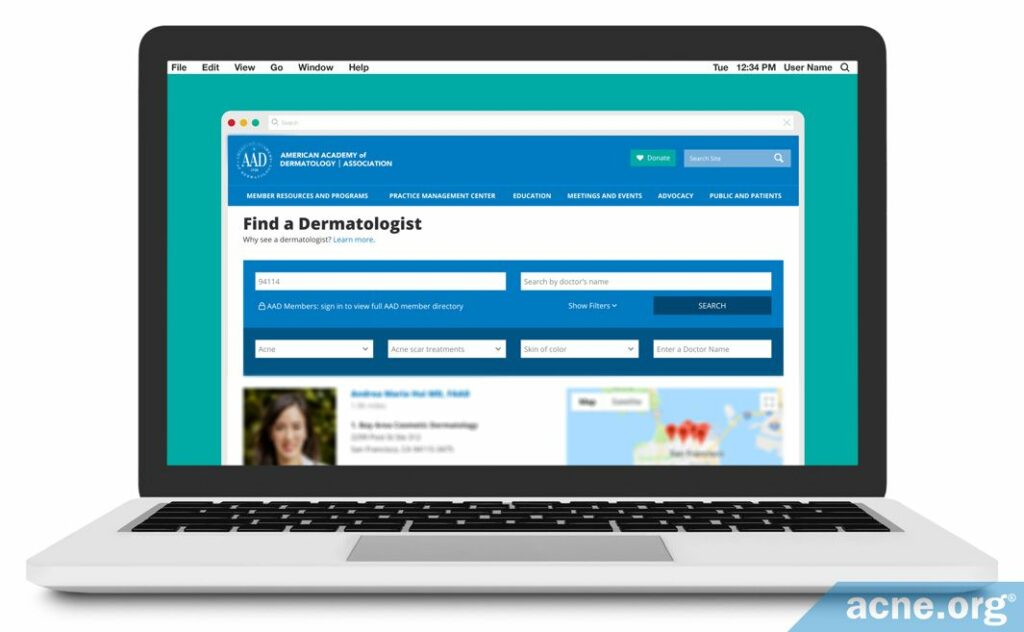
You can find those doctors who have made treating acne their priority in three simple steps:
- Find a board-certified dermatologist: Use the search feature on the American Academy of Dermatology (AAD) website, and type in your zip code to find a board-certified dermatologist near you.
- Filter for dermatologists focusing on acne: Narrow down your search results on the AAD website by choosing “Acne” in the “Any condition” box to find those dermatologists who have a particular interest in acne.
- [Optional] Filter by specific treatment: If you need a particular type of treatment, such as acne scar revision, select “Acne scars treatment” in the “Any procedure” field to focus on dermatologists who offer this treatment.
Keep in mind that certain other types of professionals, such as cosmetologists, also offer some acne treatments, but they are not doctors and cannot diagnose conditions or prescribe medication.8
The Bottom Line
How much a dermatologist knows about acne depends on her professional interests. The average dermatologist has some experience with acne but is not necessarily an acne expert. However, dermatologists who seek out informal education on acne and choose to focus on acne patients in their practice do become acne experts.
References
- Dermatology, A. A. of. Subspecialties of dermatology. https://www.aad.org/public/diseases/why-see-a-board-certified-dermatologist/subspecialties-of-dermatology (2019). Available at: https://www.aad.org/public/diseases/why-see-a-board-certified-dermatologist/subspecialties-of-dermatology.
- Hoey, S. So you want to be a dermatologist. Ulster Med. J. 81,172 (2012). https://www.ncbi.nlm.nih.gov/pmc/articles/PMC3632834/
- Hunter, J., Savin, J. & Dahl, M. Clinical Dermatolgy. (Blackwell Science Ltd., 2002). http://famona.sezampro.rs/medifiles/dermatology/clinicaldermatology 4thedition.pdf
- Burns, T., Breathnach, S., Cox, N. & Griffiths, C. Rook’s Textbook of Dermatology. (John Wiley & Sons, Ltd., 2010). https://www.wiley.com/en-us/Rook’s+Textbook+of+Dermatology%2C+8th+Edition-p-9781118697757
- Wilmer, E. N., Gustafson, C. J., Davis, S. A., Feldman, S. R. & Huang, W. W. Most common dermatologic conditions encountered by dermatologists and nondermatologists. Cutis 94, 285 – 292 (2014). https://www.ncbi.nlm.nih.gov/pubmed/25566569
- Knutsen-Larson, S., Dawson, A. L., Dunnick, C. A. & Dellavalle, R. P. Acne Vulgaris: pathogenesis, treatment, and needs assessment. Dermatol. Clin. 30, 99 – 106 (2012). https://www.ncbi.nlm.nih.gov/pubmed/22117871
- Landis, E. T., Davis, S. A., Taheri, A. & Feldman, S. R. Top dermatologic diagnoses by age. Dermatol. Online J. 20, (2014). https://www.ncbi.nlm.nih.gov/pubmed/24746305
- American Academy of Dermatology. Basic Dermatology Curriculum. http://www.aad.org/education-and-quality-care/medical-student-core-curriculum (2019). Available at: http://www.aad.org/education-and-quality-care/medical-student-core-curriculum.
